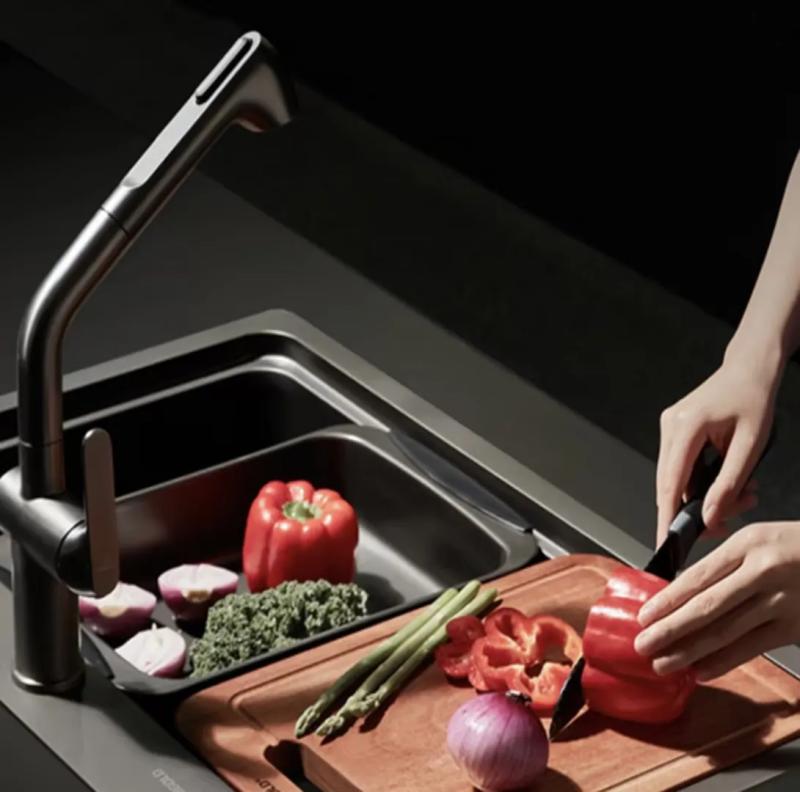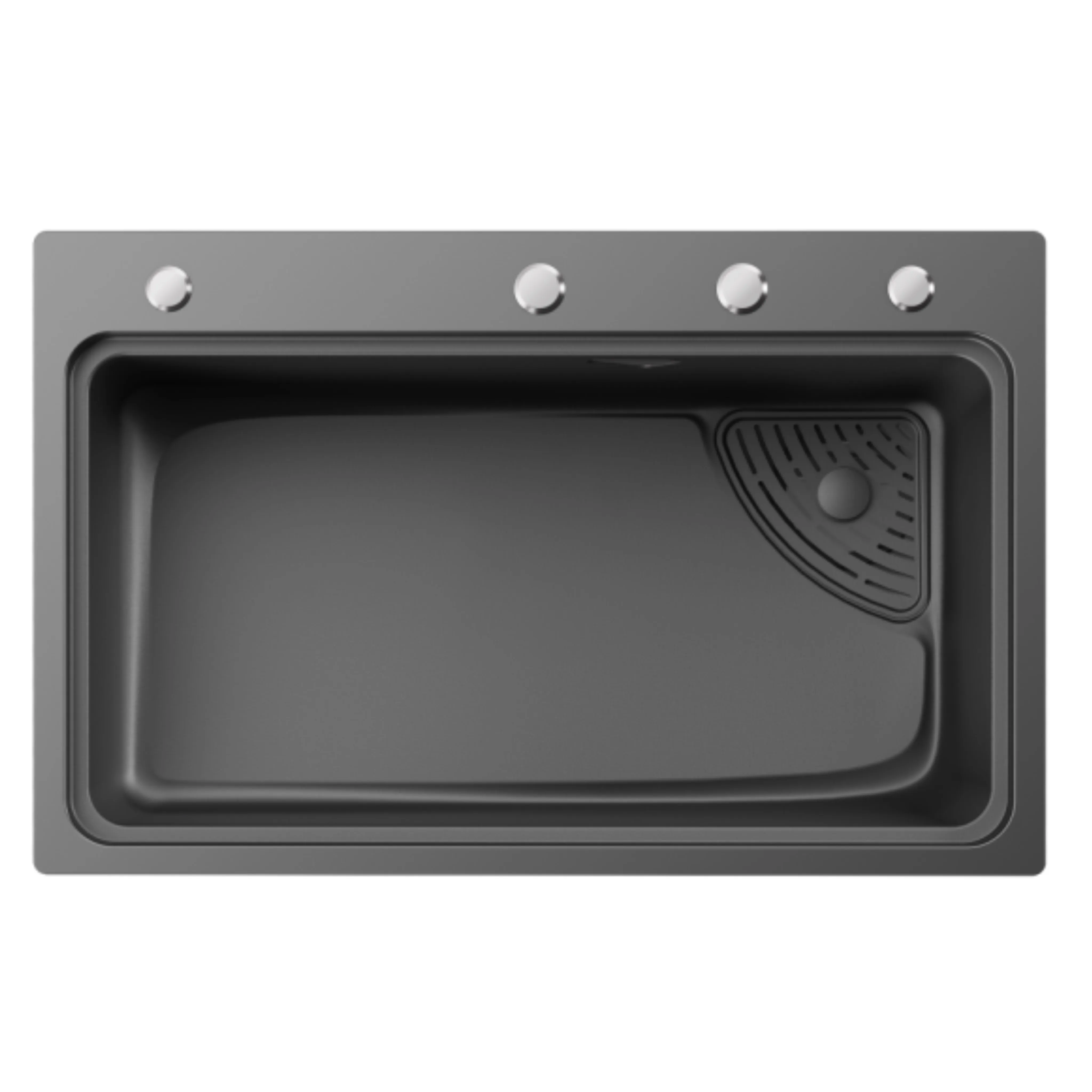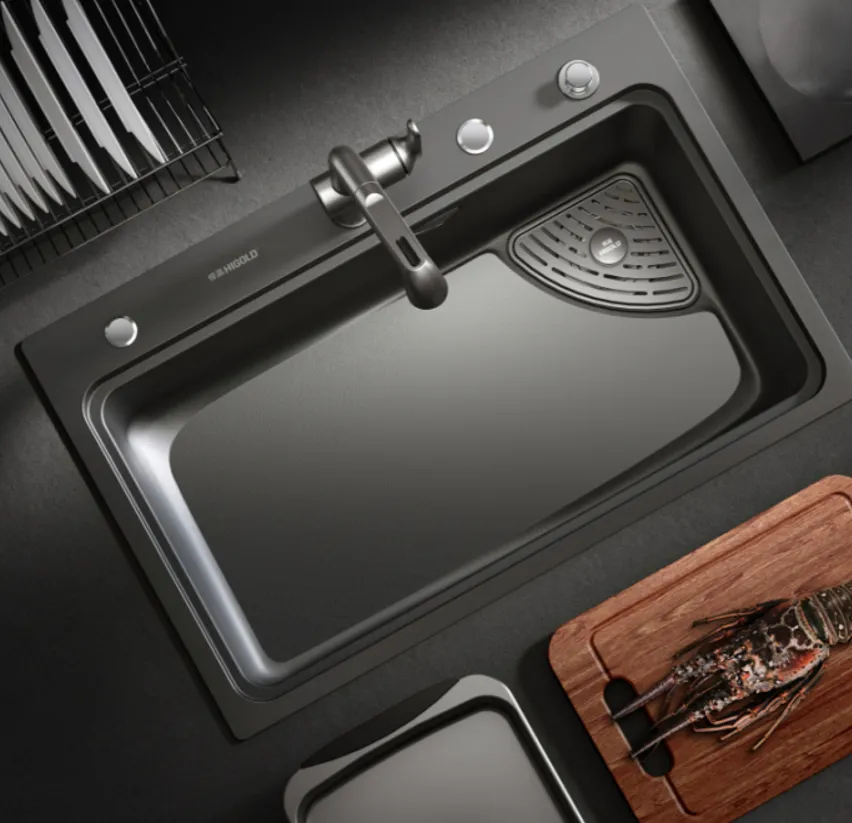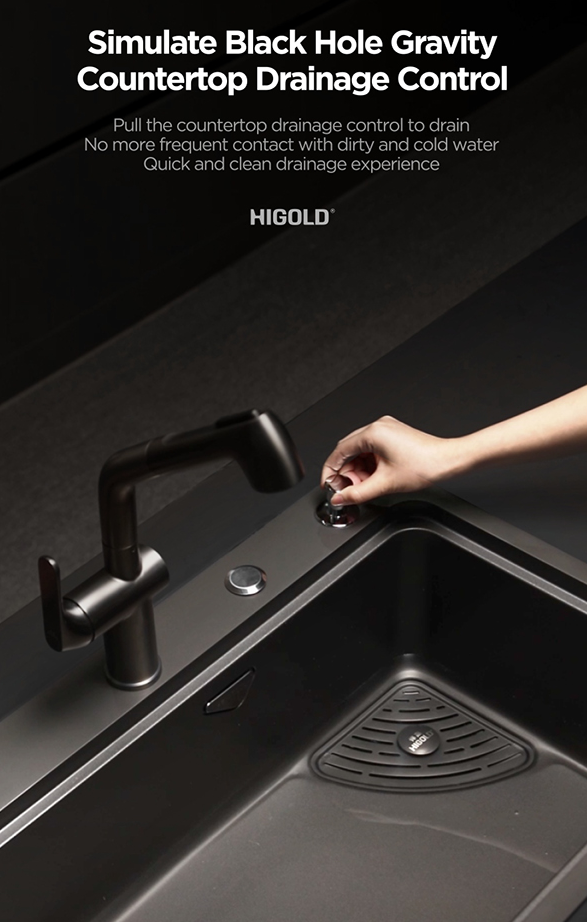As a frequently used core component in the kitchen, the sink's appearance and material selection directly impact the overall kitchen experience. In recent years, black kitchen sinks have become increasingly popular among consumers due to their unique visual appeal and stylish aesthetic.
However, many people also wonder: Are black kitchen sinks difficult to keep clean? This article systematically analyzes the cleaning issues of black kitchen sinks from multiple perspectives, detailing the material properties, stain visibility, daily maintenance methods, and comparisons with more common sinks like stainless steel, striving to provide consumers with a professional and clear answer.

Black Kitchen Sinks: What Materials Are They Made of?
To answer the question of "Are black kitchen sinks difficult to keep clean?", we must first understand their material composition.
1. Quartz Composite Black Kitchen Sinks
This type of black kitchen sink is typically made by pressing a mixture of quartz sand, polymer resin, and pigment. Its surface is delicate, uniform in color, and has a high hardness, making it resistant to some scratches. Because black has a concealing effect, these black kitchen sinks are less likely to show minor stains or scratches, often appearing "clean."
2. Coated or Nanotechnology Black Kitchen Sinks
Another type of black kitchen sink is made from a traditional stainless steel base, enhanced with PVD coating, electroplating, or nano-coating technology to achieve a black or dark gray appearance. These sinks retain the toughness of stainless steel while maintaining a black appearance, but the surface requires careful maintenance to prevent scratches and chemical corrosion.
In summary, black kitchen sinks offer both durability and decorative appeal. However, their darker color and different surface characteristics from traditional stainless steel often lead to disagreements among consumers about cleaning.
What are the challenges of cleaning a black kitchen sink?
While black kitchen sinks may appear stylish and simple, they do present some specific challenges during daily cleaning.
1. The appearance of water stains and scale
A black kitchen sink often appears spotless and tidy right after cleaning. However, if the water is hard, residual water stains and scale can form grayish-white marks on the surface. These marks stand out against a black background and are often a source of consumer complaints.
2. Grease and Residue
During kitchen cleaning, it's common for grease, seasoning juices, or fruit and vegetable residue to come into contact with the sink. While a black kitchen sink doesn't easily develop an oily film in the first place, with increased use, if not cleaned promptly, the oil can erode the surface's original matte finish, leaving it looking dull and lusterless.
3. Limited Cleaning Options
Coated black kitchen sinks should not be cleaned with steel wool or strong acid or alkaline cleaners, as this can damage the coating. This means users must be more cautious in choosing cleaning tools and detergents.
Thus, while black kitchen sinks appear more "stain-resistant," maintaining a consistently clean surface requires more rigorous maintenance practices.

What are the cleaning advantages of black kitchen sinks? - Convenience
Also, in line with the difficulties mentioned above, black kitchen sinks also offer a certain level of cleaning convenience.
1. Color Hides Minor Imperfections
Black kitchen sinks offer excellent coverage for minor scratches and stains. Compared to traditional, glossy silver stainless steel sinks, the black surface doesn't reflect light significantly, making minor imperfections difficult to notice during daily use.
2. Overall Appearance: More "Stain-Resistant"
Visually, black kitchen sinks are better at concealing everyday debris than lighter-colored sinks. Even small amounts of grease or dust are less noticeable from a distance. This characteristic leads some consumers to believe that black kitchen sinks are easier to maintain a "neat" appearance.
3. Cleaning Frequency Can Be Adjusted to Your Needs
Unlike lighter or silver sinks, which require immediate wiping after each use to avoid stains, black kitchen sinks offer greater flexibility in appearance, allowing users to adjust their cleaning frequency based on their needs.
In other words, black kitchen sinks aren't truly "easier to keep clean," but rather "less visible."
Black kitchen sinks vs. stainless steel sinks: Which is easier to keep clean?
To better understand the cleaning challenges of black kitchen sinks, it's helpful to compare them with the most common stainless steel sinks.
1. Water stains
• Stainless steel sinks: Water stains can appear as spots or dull areas, affecting the gloss.
• Black kitchen sinks: Water stains appear off-white, contrasting sharply with the dark surface and making a more direct visual impact.
2. Oil stains
• Stainless steel sinks: Oil stains easily spread and create a glare on the surface. If not wiped dry after cleaning, they can still appear greasy.
• Black kitchen sinks: Oil stains may not be noticeable for a short time, but over time, accumulation can affect the surface texture.
3. Cleaning Difficulty
• Stainless steel sinks: They are durable and offer a wide range of cleaning tools, including steel wool and scouring powder.
• Black kitchen sinks: Cleaning tools are limited, so avoid using overly harsh tools or corrosive cleaners.
While black kitchen sinks appear easier to keep clean, they require more meticulous care than stainless steel sinks.

Daily Care and Cleaning Tips for Black Kitchen Sinks
To prevent black kitchen sinks from appearing difficult to clean due to water stains, grease, or damaged coatings, effective daily care is essential.
1. Prompt Rinse and Dry
After each use, it's best to rinse your black kitchen sink with clean water and wipe the surface dry with a soft cloth or sponge to prevent scale buildup.
2. Choose the Right Cleaner
It's recommended to use a neutral detergent or a dedicated sink cleaner; avoid using strong acids or alkalines. For quartz composite black kitchen sinks, a diluted neutral solution can be used to remove stubborn stains.
3. Avoid Impact with Hard Objects
Black quartz composite kitchen sinks, while hard, are also relatively brittle. Avoid impacts from heavy metal pots and pans.
4. Regular Deep Cleaning
We recommend a weekly deep cleaning using a mixture of baking soda and warm water to effectively remove oil film and light limescale.
With proper cleaning methods, a black kitchen sink can be kept clean and beautiful for a long time.
A Comprehensive Evaluation of the Difficulty of Cleaning a Black Kitchen Sink
Based on the above analysis, we can conclude:
Black kitchen sinks are not truly "difficult to keep clean." Compared to stainless steel sinks, they visually conceal stains better, giving the impression of being more resistant to dirt.
What's important to note is that cleaning a black kitchen sink requires more careful attention to the cleaning methods and tools used. Improper handling can result in noticeable water stains or damage to the surface.
Black kitchen sinks require slightly higher cleaning and maintenance costs than stainless steel sinks, but with good habits, maintaining cleanliness and beauty is completely manageable.

"Is a black kitchen sink difficult to keep clean?"
The answer to this question isn't a simple "yes" or "no."
Black kitchen sinks, with their stylish and visual appeal, add a touch of class to any kitchen space. They also hide minor stains and scratches better than traditional stainless steel. However, maintenance demands a more meticulous cleaning regimen and meticulous care.
Whether a black kitchen sink is "difficult to keep clean" depends on the user's cleaning habits and maintenance methods. With proper rinsing, prompt drying, and the right cleaning tools, a black kitchen sink is not difficult to clean; instead, it maintains its elegant appearance over time, becoming a focal point in the kitchen.
How does Higold's ODM service benefit international brands?
Higold's ODM service is ideal for brands that want to launch unique kitchenware without investing heavily in their own R&D. The design team develops exclusive models, tests prototypes, and manages mass production under strict quality control. Buyers receive products that reflect their brand identity while benefiting from factory-direct prices. This saves time, reduces costs, and ensures strong market entry for innovative kitchen sinks and faucets manufactured in China.


